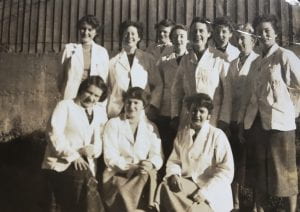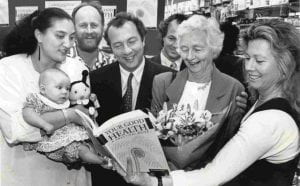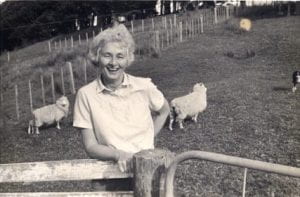This biography is based on an interview with Katharine Bowden nee Thomson in 2018 for the Early Medical Women of New Zealand Project. The interviewer was Cindy Farquhar.
Contents
Early life
Katharine Thomson was born in 1928 in the Auckland suburb of Parnell. Her father was a lawyer and her mother came from a farming family in the Wairarapa. Unusually for the time, Katharine’s mother had studied medical intermediate at university until she married. Katharine was delivered at home by Doctor Hilda Northcroft, an obstretrician and early feminist. After a long labour and a difficult birth, her mother decided not to have any more children.
Katharine attended Parnell School for two years. Then, other than a year spent in Masterton while her father was in the army, she was educated at Diocesan School for Girls in Epsom. When she was 14, Katharine had a non-malignant bone tumour removed from her femur, which shortened one leg. Katharine often used this to avoid participating in sports—other than swimming, which she loved. Boarding at Diocesan, with its compulsory evening study, transformed Katharine from an ordinary student into a high achiever. She excelled at English Literature and Botany, was Head Prefect, and then became Dux in her final year.
Encouraged by her mother, Katharine enrolled in medical intermediate at Auckland University but getting into medical school was not at all straightforward. As with almost all girls’ education at the time, she had studied very little science and found that despite being Dux, she was well behind her male counterparts in every subject.
“We really went to university not knowing amps from watts from ohms.”
The competition was fierce, and Katharine did not get in on her first attempt. Those who just missed out were encouraged to repeat the year, but she found it a soul-destroying experience to study the same material, only to find that she had missed out again. So Katharine decided to forget about medical school and began a Bachelor of Science instead. Fortunately, a persistent physics lecturer encouraged her to give it a third go, and to her delight she was accepted. Her parents were thrilled for her too, although saddened that she was suddenly leaving home.
Medical school
It was 1950 and Katharine had just celebrated her 21st birthday, when she made the arduous two-day train and boat trip from Auckland to Dunedin. Having left hastily, she arrived with no accommodation arranged and was only able to find a rather dire boarding house run by two elderly women. However, she was soon accepted into St Margaret’s Halls of Residence where she stayed for two years. After that she lived in the ‘chookery’—a Dunedin institution—a huge, decrepit house on George Street, with eight other female students. Despite two years in a bedroom that faced due south, Katharine found freedom in the large share house, and made friends for life.
On the first day of medical school, Katharine and the other eleven women were told to sit at the front of the lecture theatre, so as not to distract the men. The women had their own common room and soon developed a natural camaraderie. But there were a range of views from both male lecturers and students about their female cohort.
“A few were hostile, they felt our places should have gone to returned soldiers, or that we’d waste our training by getting married and having babies.”
Katharine loved the Dunedin life, especially the opportunities to tramp in the mountains of Central Otago.
Over the long summer breaks, Katharine returned to Auckland working in a variety of summer jobs—as a gardener, a factory worker at the Nestle chocolate factory, and at Donaghy’s Rope and Twine. Eventually her aunt, a senior nurse, who was sick of young doctors arriving in wards with no idea of the hospital environment, encouraged her to start working as a nurse aid, which Elizabeth did for three summers.

Back row (left to right): Margaret Belton (nee Hart), Bronwyn Robinson (nee Broomfield), Pat Bassett, Joan Kerr, [unknown], Kathleen Bradford (nee Johnstone), Elizabeth Naylor (nee Beauchamp), Katharine Bowden (nee Thomson).
Front row (left to right): Margaret Gibberd (nee Sidey), Ann Weston (nee Coates), Gwen Allison (nee Hookings)
Academically, medical school was a challenge for almost all the students. The volume of work was horrendous and little attention was paid to delivering the material effectively. Katharine failed her first practice exams, along with a third of the class.
“I was often overwhelmed by it, and I never would have passed if my future husband hadn’t taken me in hand and said, “Look, you can do this perfectly well”. Bernard had completed a science degree and taught before starting medical school. He was in the year ahead and was an excellent and very encouraging tutor.”
Katharine found the anatomy labs particularly hard-going, and vividly remembers the smell. Professor Adams of anatomy was a terrifying character who bellowed questions at the students, always putting them on the spot. Biochemistry was also at a developing stage and completely unfamiliar territory. Katharine felt the medical course lacked a defined curriculum at times, with a poor of balance between basic science and clinical education.
“We had about two terms on neuromuscular nerve endings, and half a lecture on the ear, and half a lecture on the eye. And how well you did in any subject, depended a great deal on who taught it.”
Katharine’s favourite subject was general medicine. By the fourth year the class was ranked by merit into six groups A-E. Katharine was in group C but was fortunate to train under Professor Iverach, who was an excellent teacher. His group of students performed much better than others during the exams. In fifth year, the students completed an independent research project, and Katharine chose to study diabetes in children under ten—a subject which remained an interest throughout her career. Katharine spent her final sixth year of training in Auckland, mostly at Auckland City and Greenlane Hospitals.
Early training in Gisborne & Auckland
Katharine and Bernard Bowden were married a week after her graduation in 1954. The couple then moved to Gisborne, where both were employed as house surgeons at Cook Hospital. The chief physician at Gisborne Hospital, Theodora Hall, had been to university with Katharine’s mother and was married to a surgeon—Dick Hall. The couple were sympathetic to another husband and wife team and acted as role models for Katharine and Bernard.
“It was so remote and quite out of my experience as a city dweller. Theo was a magnificent Physician and I’d have happily stayed there.”
Bad weather would frequently cut off all access to the district and on a few occasions, Katharine flew with her patients to Auckland Hospital for the treatment of serious medical complaints.
“My clearest memory is of a child who had inhaled something—nobody could work out what. It was in fact a crayfish leg, and the more they tried to grab it, the more damage they did. Sadly, the baby died. The grandmother must have known what was in there, but she was too afraid to reveal it.”
By and large though, Theo and Dick in their many years in Gisborne, had succeeded in changing the attitude of the local iwi towards accepting pakeha medical treatment.
After a year, the couple decided to return to Auckland so that Bernard could pursue ophthalmology. Meanwhile Katharine worked as a house surgeon in Greenlane’s casualty department. The hours could be long, but the atmosphere was very good, and she was treating every ailment imaginable.
“Motor mowers had just come into fashion, and the number of terrible accidents was alarming. People had no idea what they were doing.”
Advised by her employers that the patients would not like to be treated by a pregnant woman, Katharine stopped working when she was about five months pregnant. Her son Tom was born in National Women’s Hospital in 1956, assisted by obstetrician Bernard Kyle.
Family Planning while starting a family
The following year, Katharine bumped into Dr Isabel Houghton—a senior public health doctor—who asked, “Why aren’t you working?” Isabel organised Katharine a part-time job immunising children. Katharine would bribe her friends to look after her baby while she worked. She found the work somewhat tedious and was grateful to be offered locum work for Dr Ruth Black in Family Planning, a new path that would shape much of her career.
In the late 1950s, Family Planning was in its infancy and the first Auckland clinic was located above a mechanic’s workshop on Remuera Road. Patient numbers were increasing, as women looked for some control over their own fertility. Diaphragms and spermicides were the main contraceptive methods available at the time. Condoms were not usually recommended due to the need to involve the man. A lot of couples were relying on natural family planning and the withdrawal method.
Katharine’s developing interest in Family Planning exposed the lack of education in some subjects provided at medical school.
“There were two lectures on birth control, and one was entirely for the men, not for the women. Then, the women were allowed to go to the second one, but it consisted largely of stories, rather than any useful information.”
Working in the United Kingdom: general practice & Family Planning
In 1957, Katharine and Bernard went to England for further training. They travelled by ship via the West Indies and the Panama Canal. Bernard worked on board as the ship’s doctor, which he loved, while Katharine had the difficult task of occupying a very active one-year-old in their tiny quarters for seven weeks.
In London, Bernard studied and worked as a house officer and Katharine worked as a part-time assistant in a general practice. She was rostered on three afternoons a week—Friday, Saturday, and every other Sunday. She was paid five pounds a week and given accommodation for the family. Unlike the New Zealand system, the British NHS was free and so people didn’t hesitate to come to see the doctor for every little thing. Katharine always feared that among the slew of minor ailments, she might miss something really important. Her employer was Jewish and ministered to a largely Jewish community in North London.
“Dr Dymond was very kind to me and to my family. He did however have a very short attention span, so I learnt in the handover sessions to say the most critical words straight off the bat! It was hard going, because I wasn’t experienced enough really.”
After 18 months working in London, the family moved to Bristol so that Bernard could take up work as a senior registrar. The couple had two more children during this time, and with live-in help from a family friend, Katharine was able to take on part-time training at Family Planning. This was a formative experience, working with very good doctors who were pioneers in the field.
Starting a Family Planning clinic in Whangarei

When Katharine and her family returned to New Zealand in 1960, they settled in Whangarei, north of Auckland. Katharine and Bernard helped establish marriage guidance in Whangarei both working as trainers through the 1960s and 70s. With strong encouragement from pioneering paediatrician, Alice Bush, Katharine started up her own Family Planning clinic, working voluntarily at first to get the practice up and running. She was the third doctor in New Zealand to join the fledgling movement.
“Alice had written to me in England saying, ‘I’m telling the community that there will be a Family Planning clinic here next year….” At one meeting after I arrived, she saw Mavis Hurrey in action as the Secretary of the YWCA. Alice said, “whoever that is, get her involved, she knows absolutely everybody and she’s great.” I did, and Mavis was a marvellous stalwart of the clinic up until she died. Alice was remarkably good at spotting talented people and persuading them to join the cause. She was completely tireless and well ahead of her time.”
At first, Katharine experienced considerable opposition from local GPs. Some were possessive about their patients, many didn’t see why specialist fertility services for women were needed, and others were ideologically opposed. It took many years but eventually even the Catholic doctors started referring patients to Family Planning.
Katharine worked in Family Planning for the following 19 years and saw many changes in the contraception available to women and families. While in the UK she had seen the introduction of the contraceptive pill and that women were prepared to suffer the incredible nausea that often accompanied these early versions.
“There were notices saying, you can try this—we believe it’s safe. I think the first woman I gave it to in New Zealand, took to her bed.”
Intrauterine devices were also introduced but they were difficult to insert and could be challenging for a doctor working alone in a small clinic. The number of women requesting abortions also increased over time, and a legislation change in the mid-1970s allowed for these procedures under some circumstances.
It was daunting but very exciting to be at the forefront of these social changes, many of which had a profound effect on people’s lives and relationships. Katharine made many close friendships through her Family Planning work. Over time, many more women doctors joined the clinic, more user-friendly options for contraception evolved, and she found there was widespread community acceptance of women’s right to control their fertility.
The Cook Islands
Throughout the 1960s and 70s New Zealand provided specialist medical services to the Cook Islands. Bernard had been asked to assist several times but had always felt they were too busy and had too many children. But in 1973, no a whim the couple decided to go to the Cook Islands for 3 weeks, with Bernard providing ophthalmology and Katharine providing anaesthetic services. When it came time to leave the islands, their plan failed to arrive. However, an additional week stranded on Aitutaki cemented their new friendships and their shared love of the Pacific, and Katharine returned to the Cook Islands many, many times over the following thirty years. Katharine was eventually made an Honorary Citizen for her contribution to the health services of the Cooks.
The highlight: starting a solo family practice in Ngunguru
Katharine’s decision to go into Family Planning rather than general practice was partly pragmatic. At the time there was no flexibility, and general practitioners were required to deal with emergencies and deliver babies at any time of the day or night. As a mother of now six children, Katharine was not able to commit to that. However, she kept the idea of returning to general practice in the back of her mind, hoping to re-train when her youngest child started school.
After Bernard was diagnosed with incurable lymphoma in 1975, Katharine spent the majority of her time looking after her husband and six children. However, in 1977 she took on the biggest challenge of her career—starting her own general practice clinic in Ngunguru. As two decades had passed since she had worked in general practice in the UK, Katharine needed to devote many hours studying and attending lectures before completing the requirements of the Royal New Zealand College of General Practitioners.
At first, Katharine ran her practice from a local motel unit, until the Christmas period made it unavailable, forcing her to operate entirely via home visits. Eventually she purchased a cottage on Shoebridge Road, adding a custom-built surgery at the rear. Activities on the coast differed from the city and as a result the injuries varied widely, from fishhooks (hooked in every place imaginable), wasp attacks, blue-bottle stings, asthma, to severe sunburn. ‘Forgotten to pack’ medication and the odd car that left the road were often on the agenda too.
“I was paid in a variety of ways—fish, pipis, kumara, and once memorably with charcoal, from the local wood-burner. I had so many adventures, felt privileged to work in the area, and came to know many generations of local iwi. My 13 years in general practice here, was my favourite part of a thoroughly enjoyable career.”

While in general practice and after Bernard died in 1980, Katharine joined the Northland Area Health Board, which was the first hospital Board in New Zealand to become a Health Board. Transforming the health system of the region to harmonise the hospital with public health, as a first line of attack, was a fascinating and demanding process. Her background in community politics from her Family Planning days was invaluable. From the early 1980s Katharine became involved with Hospice and remained so for the best part of thirty years as a Board Member and as a volunteer in various fields from nurse aiding to helping with biographies.
Katharine retired from her Ngunguru General Practice in 1988 and worked as a locum until 1998. In the Queen’s Birthday Honours of 2001, she was awarded membership of the New Zealand Order of Merit (MNZOM) for services to medicine and public health.
In retirement, Katharine now lives on the 300-acre farm that she and Bernard bought in 1966. It has a magnificent view and is run as conservation project with her six children, their spouses and her eleven grandchildren.
“We weren’t farmers and knew nothing about the land but a third of the property was in old growth bush, which we fenced off. Then over the decades we became very passionate about ecology and replanted more and more of the land in natives. I’m very proud that it’s all a sanctuary now.”
